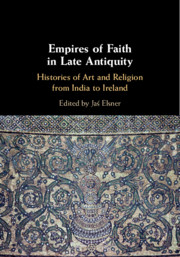Book contents
- Empires of Faith in Late Antiquity
- Empires of Faith in Late Antiquity
- Copyright page
- Contents
- Figures
- Contributors
- Acknowledgements
- 1 Introduction
- Part I The Imperial Context
- Part II After Imperialism: Orientalism and its Resistances
- 8 The Road from Decadence: Agendas and Personal Histories in the Study of Early Islamic Art
- 9 Connecting Art and Zoroastrianism in Sasanian Studies
- 10 ‘Hindu’ Art and the Primordial Śiva
- Part III Post-Colonialist, Old Colonialist and Nationalist Fantasies
- Bibliography
- Index of Names
- Index of Subjects
9 - Connecting Art and Zoroastrianism in Sasanian Studies
from Part II - After Imperialism: Orientalism and its Resistances
Published online by Cambridge University Press: 29 February 2020
- Empires of Faith in Late Antiquity
- Empires of Faith in Late Antiquity
- Copyright page
- Contents
- Figures
- Contributors
- Acknowledgements
- 1 Introduction
- Part I The Imperial Context
- Part II After Imperialism: Orientalism and its Resistances
- 8 The Road from Decadence: Agendas and Personal Histories in the Study of Early Islamic Art
- 9 Connecting Art and Zoroastrianism in Sasanian Studies
- 10 ‘Hindu’ Art and the Primordial Śiva
- Part III Post-Colonialist, Old Colonialist and Nationalist Fantasies
- Bibliography
- Index of Names
- Index of Subjects
Summary
A stark divide lingers between the themes and problems addressed by art historians and those explored in historical accounts of Zoroastrianism under the Sasanian Persian Empire (224–651). Although shaped by numerous intertwined investments and catalysts over the centuries, the divergence in the attentions of the two fields crystallized during imperial and anti-imperial movements of the nineteenth and twentieth centuries, active both within Iran and without. Art has been framed as irrelevant for the history of Zoroastrianism, demonstrating the absence and avoidance of religious themes; at the other end of the scale, art has been seen as, containing innate sacred significance in its composition. Certain narratives central to the development of Sasanian studies - of continuity, exceptionalism, and eurocentricism, in particular - have shaped approaches to how iconography and art can be incorporated into discussions of Sasanian religion. Convergent interests have promoted the continuity of iconography’s sacred meanings from earlier in antiquity through the Sasanian period to the modern day, diminishing the contemporary contribution and context, and see the visual evidence as demonstrating the distinctiveness and exceptionalism of Zoroastrianism from other religions, and of Iranian culture from others.
- Type
- Chapter
- Information
- Empires of Faith in Late AntiquityHistories of Art and Religion from India to Ireland, pp. 223 - 259Publisher: Cambridge University PressPrint publication year: 2020



